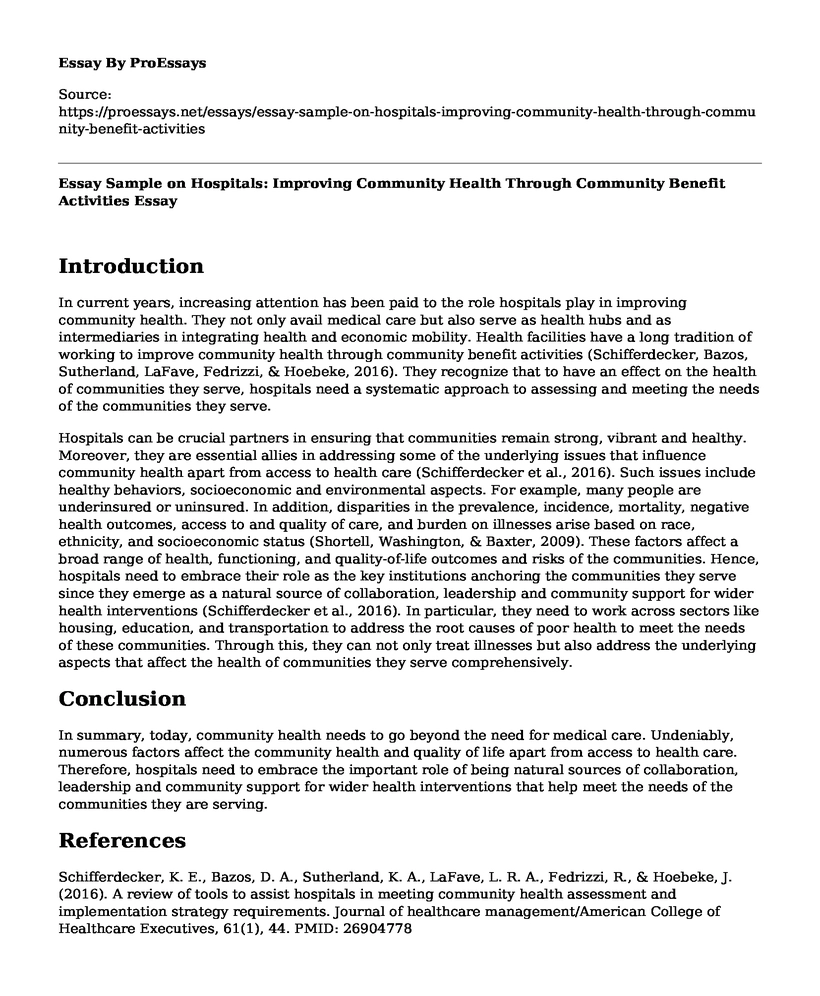Introduction
In current years, increasing attention has been paid to the role hospitals play in improving community health. They not only avail medical care but also serve as health hubs and as intermediaries in integrating health and economic mobility. Health facilities have a long tradition of working to improve community health through community benefit activities (Schifferdecker, Bazos, Sutherland, LaFave, Fedrizzi, & Hoebeke, 2016). They recognize that to have an effect on the health of communities they serve, hospitals need a systematic approach to assessing and meeting the needs of the communities they serve.
Hospitals can be crucial partners in ensuring that communities remain strong, vibrant and healthy. Moreover, they are essential allies in addressing some of the underlying issues that influence community health apart from access to health care (Schifferdecker et al., 2016). Such issues include healthy behaviors, socioeconomic and environmental aspects. For example, many people are underinsured or uninsured. In addition, disparities in the prevalence, incidence, mortality, negative health outcomes, access to and quality of care, and burden on illnesses arise based on race, ethnicity, and socioeconomic status (Shortell, Washington, & Baxter, 2009). These factors affect a broad range of health, functioning, and quality-of-life outcomes and risks of the communities. Hence, hospitals need to embrace their role as the key institutions anchoring the communities they serve since they emerge as a natural source of collaboration, leadership and community support for wider health interventions (Schifferdecker et al., 2016). In particular, they need to work across sectors like housing, education, and transportation to address the root causes of poor health to meet the needs of these communities. Through this, they can not only treat illnesses but also address the underlying aspects that affect the health of communities they serve comprehensively.
Conclusion
In summary, today, community health needs to go beyond the need for medical care. Undeniably, numerous factors affect the community health and quality of life apart from access to health care. Therefore, hospitals need to embrace the important role of being natural sources of collaboration, leadership and community support for wider health interventions that help meet the needs of the communities they are serving.
References
Schifferdecker, K. E., Bazos, D. A., Sutherland, K. A., LaFave, L. R. A., Fedrizzi, R., & Hoebeke, J. (2016). A review of tools to assist hospitals in meeting community health assessment and implementation strategy requirements. Journal of healthcare management/American College of Healthcare Executives, 61(1), 44. PMID: 26904778
Shortell, S. M., Washington, P. K., & Baxter, R. J. (2009). The contribution of hospitals and health care systems to community health. Annual review of public health, 30, 373-383. https://doi.org/10.1146/annurev.publhealth.032008.112750
Cite this page
Essay Sample on Hospitals: Improving Community Health Through Community Benefit Activities. (2023, Jan 12). Retrieved from https://proessays.net/essays/essay-sample-on-hospitals-improving-community-health-through-community-benefit-activities
If you are the original author of this essay and no longer wish to have it published on the ProEssays website, please click below to request its removal:
- Health Insurance Plans and Their Impact on the United States Essay Example
- Cardiovascular System and Its Response to Acute and Chronic Exercise Paper Example
- The Social Determinants of Health & Poor Environmental Health - Essay Sample
- Euthanasia: Voluntary Relieving of Suffering Through Professional Assistance - Essay Sample
- Essay on Evolving Professionalism in Pharmacy: A Study of Hippocratic Values
- Giving is Greatest Gift: Nurses at the Heart of Healthcare - Essay Sample
- Generalist Practice and Voting - Essay Example







